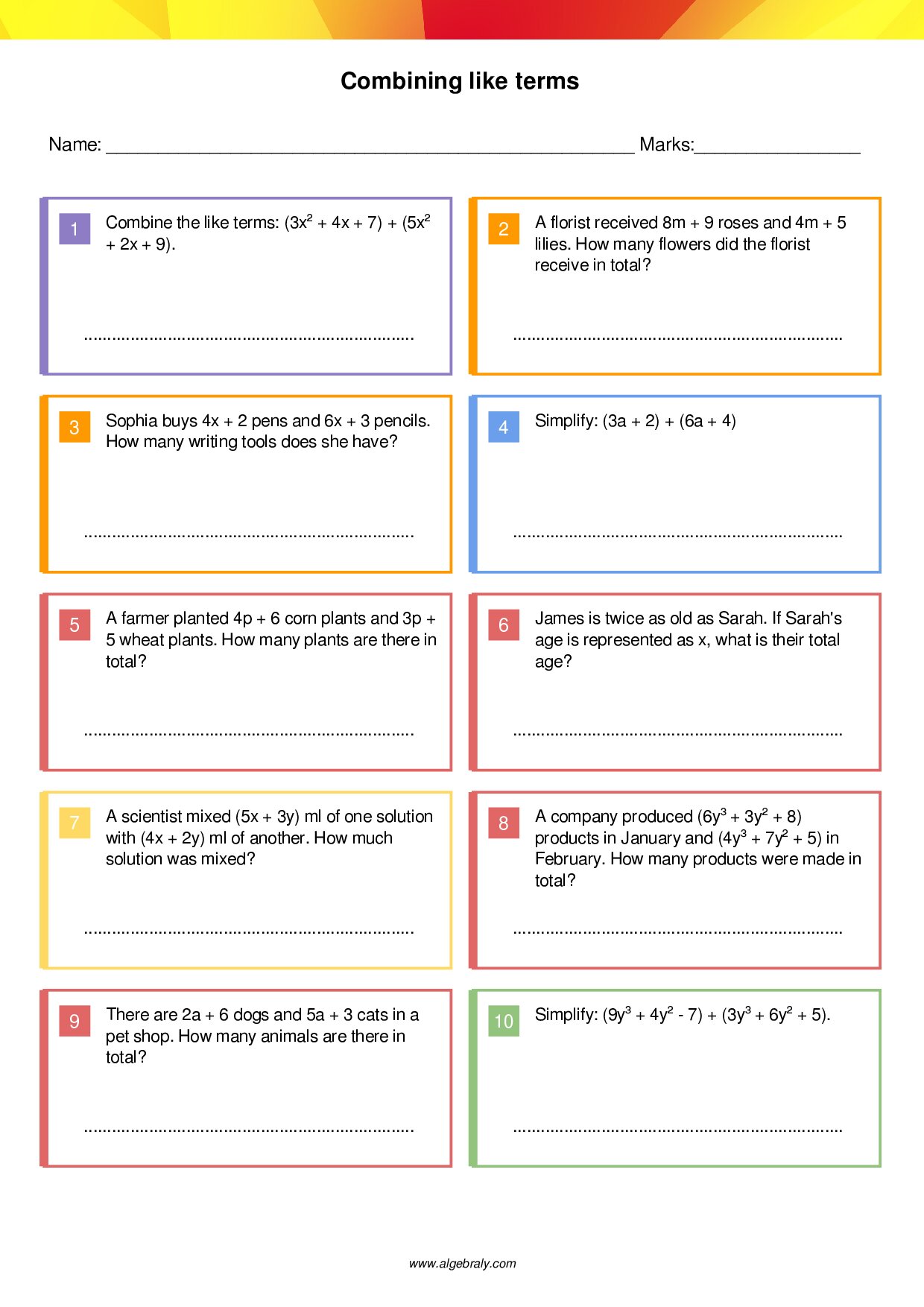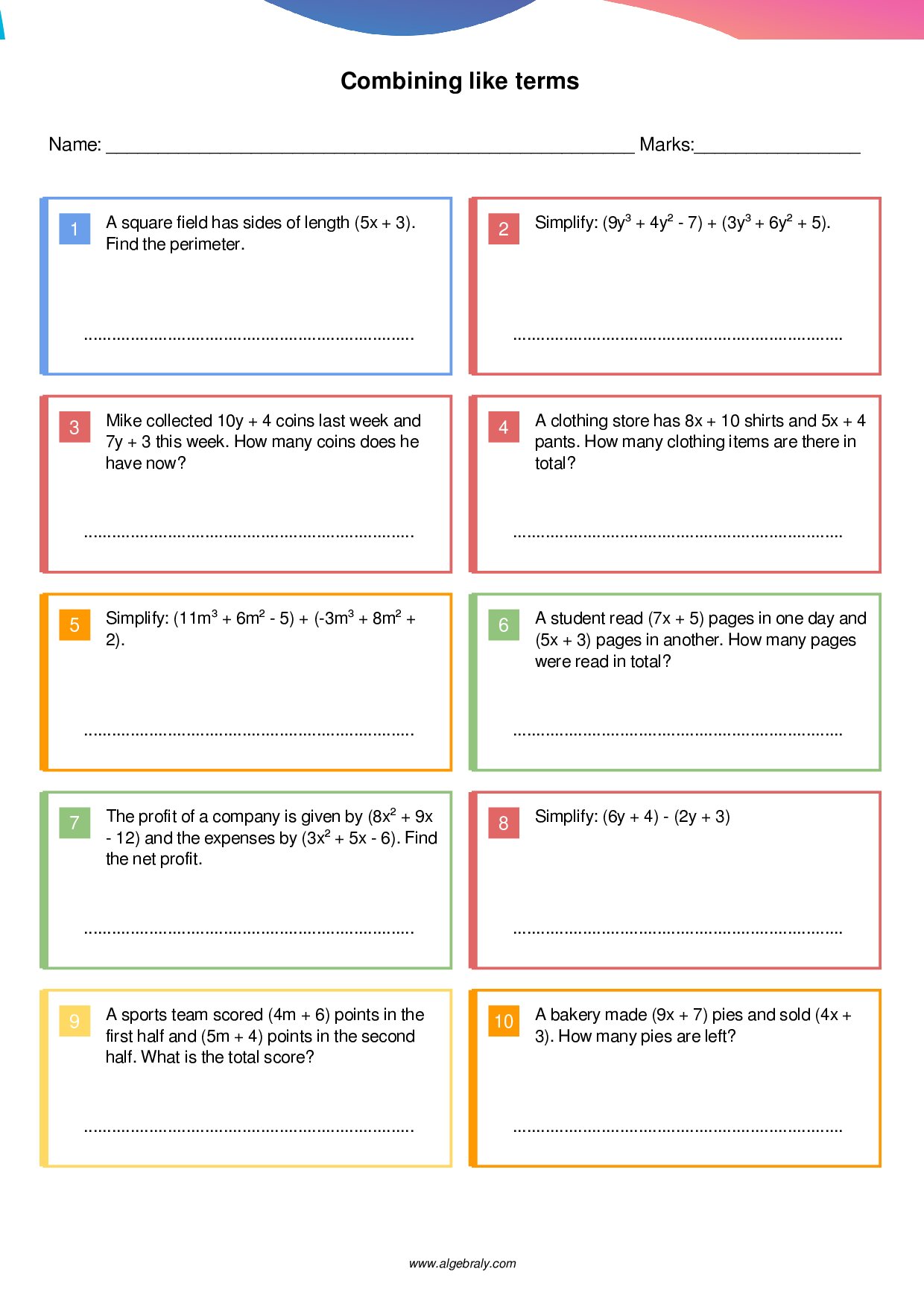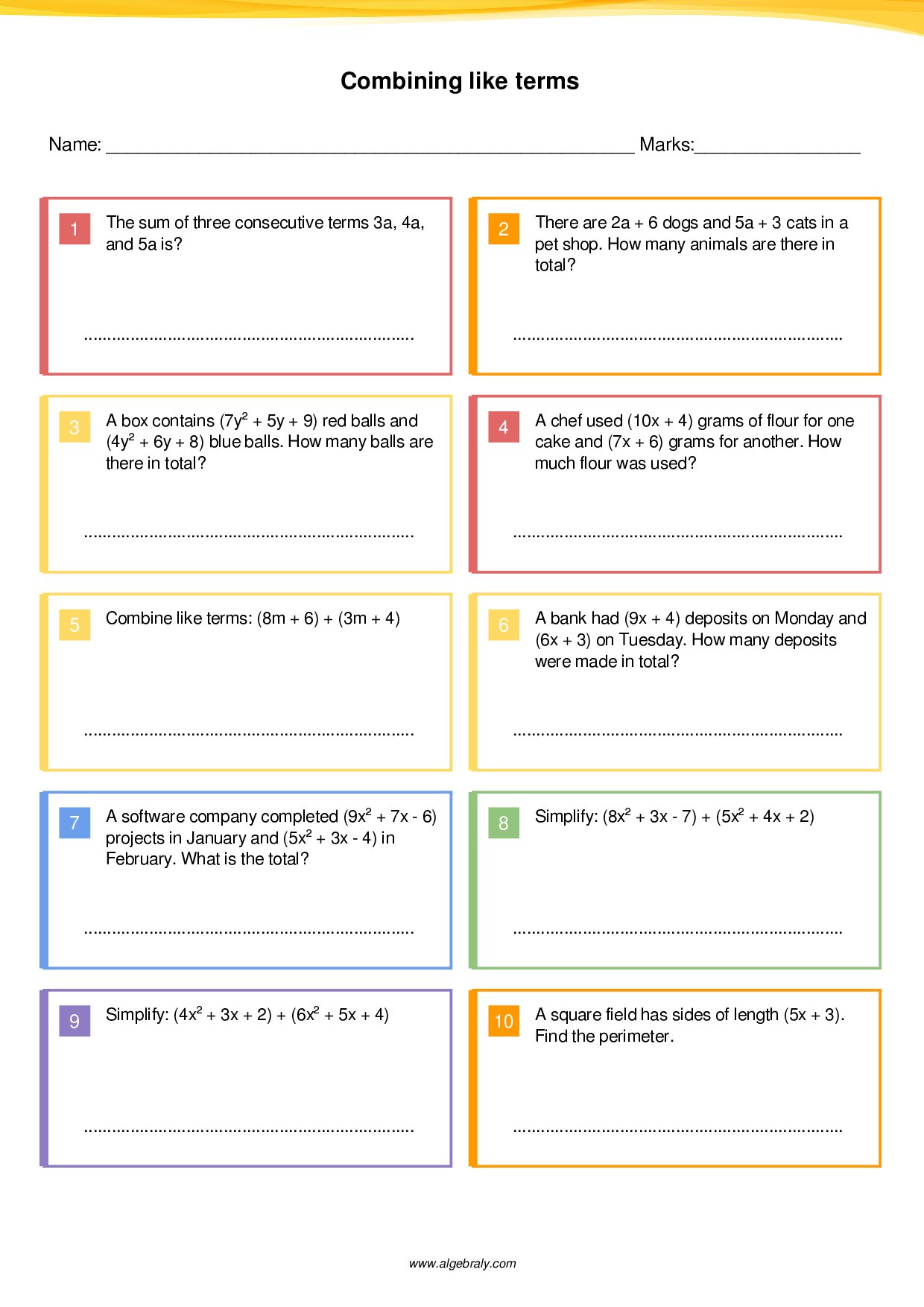Dynamically Generated Combining Like Terms Worksheet
Combining Like Terms Quiz – Word Problems
A shop sold (5x + 3) t-shirts on Monday and (3x + 2) on Tuesday. How many were sold in total?
Mastering algebra begins with a strong foundation in simplifying expressions, and that’s exactly what these combining like terms worksheets and online quizzes offer. Designed for Algebra 1 students, these worksheets feature engaging word problems that teach students how to identify and simplify algebraic expressions with ease.
Each dynamically generated worksheet includes 15 real-world story problems, ensuring students practice combining like terms with and without exponents in a relatable and practical way. Worksheets are available in PDF format, making them easy to download, print, and use for homework, classroom exercises, or extra practice. The interactive combining like terms quiz provides an engaging online alternative for students to test their skills in real-time, reinforcing their understanding through instant feedback.
What Students Will Learn
These combining like terms worksheets and quizzes focus on critical algebraic skills, including:
- Recognizing Algebraic Expressions – Understanding how mathematical statements represent real-world problems.
- Identifying Like and Unlike Terms – Distinguishing terms that can be combined.
- Adding and Subtracting Like Terms – Simplifying expressions step by step.
- Working with Exponents – Combining terms while following exponent rules.
- Applying Real-World Geometry Concepts – Using algebra in perimeter and area calculations.
- Multi-Step Operations & Logical Reasoning – Strengthening problem-solving skills through complex expressions.
Why These Worksheets Are Essential
Whether used for classroom or home, these worksheets and quizzes provide an interactive, structured, and effective approach to learning algebra. They reinforce numerical fluency, logical reasoning, and algebraic manipulation skills, ensuring students confidently solve more advanced math concepts.
Download the combining like terms worksheet PDF or take the online quiz today and help students build a solid foundation in algebra!
Skills Focused: Recognizing algebraic expressions, Understanding how variables represent, Developing problem-solving skills, Identifying like terms, Like and unlike terms in algebraic expressions, Adding and subtracting like terms, Simplifying algebraic expressions, Applying real-world geometry concepts in algebra, Multi-step operations in algebraic expressions, Order of operations while combining terms, Simplifying expressions, Logical reasoning, Improving numerical fluency and algebraic manipulation skills
How to Solve a Combining Like Terms Word Problem
A bakery made (6a + 5) cakes in the morning and (4a + 3) in the afternoon. How many cakes were made in total?
Time needed: 2 minutes
Step-by-step guide to solving an algebraic expression by combining like terms.
- Identify Like Terms
Look at the given expressions (6a + 5) and (4a + 3). Identify like terms: 6a and 4a (both have ‘a’), and 5 and 3 (constants).
- Add the Like Terms
Add the coefficients of ‘a’: 6a + 4a = 10a. Add the constants: 5 + 3 = 8.
- Write the Final Expression
The simplified expression after combining like terms is 10a + 8.
Learn More about Combining Like Terms – Frequently Asked Questions
What does it mean to combine like terms in algebra?
Combining like terms in algebra means simplifying an expression by adding or subtracting terms that have the same variable and exponent.
For example, in 3x + 5x, both terms have the variable x, so they can be combined: 3x + 5x = 8x.
How do you identify like terms in an expression?
Like terms have the same variable raised to the same exponent.
For example, in 4y² + 2y + 7y² – 5y, the terms 4y² and 7y² are like terms, as are 2y and -5y. Constant numbers, like 3 or -7, are also like terms.
What are the steps to simplify expressions by combining like terms?
1. Identify like terms – Look for terms that have the same variable and exponent.
2. Group the like terms – Arrange them together.
3. Add or subtract coefficients – Perform the operations while keeping the variables unchanged.
4. Write the simplified expression – Ensure there are no more like terms left to combine.
Example: 5x + 3 + 2x – 1 = (5x + 2x) + (3 – 1) = 7x + 2
Can you combine like terms with different exponents?
No, you can only combine terms that have the same variable and exponent.
For example, 4x² + 3x cannot be simplified further because x² and x have different exponents. However, 5y³ + 2y³ can be combined to 7y³ because both terms have y³.
What is an example of combining like terms with exponents?
Let’s simplify 6x² + 3x + 4x² – 2x:
1. Identify like terms: 6x² and 4x², 3x and -2x.
2. Combine them: (6x² + 4x²) + (3x – 2x) = 10x² + x.
3. Final answer: 10x² + x.
Why is combining like terms important in algebra?
It simplifies expressions, making equations easier to solve. Without combining like terms, algebraic expressions become unnecessarily complex, which can make solving equations more difficult. Mastering this skill helps with more advanced algebra topics, such as factoring and solving equations.
What are common mistakes students make when combining like terms?
– Adding or subtracting unlike terms (e.g., combining 3x² with 5x).
– Forgetting to include negative signs when subtracting terms.
– Misplacing coefficients and changing variables incorrectly.
– Not simplifying completely and leaving extra terms in the expression.
Example mistake:
Incorrect: 4x + 2y + 3x = 7xy (Wrong because x and y are not like terms).
Correct: 4x + 3x + 2y = 7x + 2y.
Can you combine like terms in equations?
Yes! Before solving an equation, it’s important to combine like terms on each side first.
Example:
3x + 5 + 2x = 15
First, combine like terms (3x + 2x = 5x):
5x + 5 = 15
Then, solve for x:
5x = 10 ⇒ x = 2
How does the distributive property help with combining like terms?
The distributive property expands expressions so you can combine like terms.
Example:
3(2x + 4) + 5x
First, distribute 3:
6x + 12 + 5x
Now, combine like terms:
(6x + 5x) + 12 = 11x + 12
What is an example of a real-world problem involving combining like terms?
A farmer plants 4x apple trees and 2x more in another field. He then plants 3 apple trees separately. How many apple trees are there in total?
Expression: 4x + 2x + 3
Combine like terms: 6x + 3
So, the farmer has 6x + 3 apple trees.





